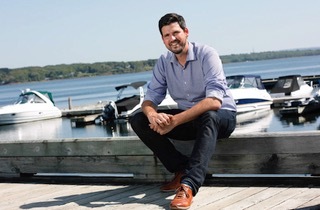Canada's New Immigration Minister Pulled in all Directions and May Increase Targets to Meet Demand

As Ontario asks the Trudeau government to send more skilled immigrants, Atlantic Canada hopes to be the big winner in Prime Minister Justin Trudeau’s cabinet shuffle.
Ontario Labour Minister Monte McNaughton recently called on the federal government to double the number of immigrants allowed into the province under a program aimed at boosting the skilled workforce.
McNaughton argues Ontario faces a dramatic labour shortage magnified by the impact of the COVID-19 pandemic. For example, The Toronto Star reported Sunday that the province is currently in need of about 14,000 construction trades workers alone.
Immigration drives Ontario's prosperity
He and Sean Fraser, Canada’s new Minister of Immigration, Refugees and Citizenship, spoke Wednesday in what Fraser described as “a great first conversation.”
Writing on Twitter, Fraser said, “we had a productive discussion about how immigration can continue driving Ontario’s short-term recovery and long-term prosperity, including addressing labour shortages in key sectors.”
Thanks to my Ontario counterpart @montemcnaughton for a great first conversation today. We had a productive discussion about how immigration can continue driving Ontario’s short-term recovery and long-term prosperity, including addressing labour shortages in key sectors.
— Sean Fraser (@SeanFraserMP) November 10, 2021
Speaking in an interview with Bloomberg News, Fraser said he’s even prepared to increase immigrant targets -- currently set at 411,000 for next year -- if he deems additional newcomers are needed to fill labour shortages.
So while Ontario’s immigration needs are genuine, many in Atlantic Canada hope Fraser keeps a steady focus on the needs of that region.
Addressing Nova Scotia's declining birthrate
A 37-year-old former lawyer from Nova Scotia, Fraser was first elected in 2015 as a Member of Parliament. He was re-elected in 2019 and 2021.
For those past five years, Fraser has campaigned in the House of Commons for increased immigration to Atlantic Canada. Nova Scotia, his province, has one of the highest proportions of seniors in Canada and a declining birthrate. Also, many young people and immigrants leave the province to work and study elsewhere.
Atlantic Canada also has the lowest immigration and retention rates in Canada, with many immigrants choosing larger gateway cities such Toronto, Vancouver or Montreal as their destination. This is despite significantly lower housing costs in Atlantic Canada.
Fredericton has high hopes for Fraser
There is a definite population crisis in Atlantic Canada.
A recent IRCC report showed that nearly 65. per cent of the Express Entry applicants prefer Ontario as the first choice for settlement. British Columbia and Quebec ranked next.
Minister Fraser understands the unique issues and context of the Atlantic provinces and we look forward to working with him on policy and programs that can help our region attract and retain more newcomers.- Krista Ross
Krista Ross, the president of Fredericton’s Chamber of Commerce, captured some of that Atlantic Canada hope for Fraser following his appointment.
“We are very pleased to see that the new federal immigration minister hails from Atlantic Canada, where population growth and workforce development issues are felt very acutely,” said Ross.
Nova Scotia seeks to double its population
“Minister Fraser understands the unique issues and context of the Atlantic provinces and we look forward to working with him on policy and programs that can help our region attract and retain more newcomers.”
Fredericton recently launched an immigration strategy aimed at attracting and retaining 1,000 newcomers annually over the next 25 years.
And Nova Scotia has set a goal of doubling its population by 2060 and, not surprisingly, immigration is a major part of achieving that goal.
Fraser predicted to focus on regional immigration
Ravi Jain, a managing senior lawyer at Green and Spiegel LLP, said he expects that Fraser will focus on regional immigration given he’s from Nova Scotia.
Writing The Lawyer’s Daily, Jain said, “besides our federal immigration programs, Canada has created the Provincial Nominee Programs and the Atlantic Immigration “Pilot” Program (now a permanent program). More recently, in the last federal election, the Liberal Party’s platform committed to establishing a Municipal Nominee Program. It will be interesting to see how the latter is developed in light of this minister’s roots.
“He will surely appreciate,” wrote Jain, “that the Atlantic region, in particular, is suffering from a low population that is not replacing itself.”
Clearing the immigration backlog is a major challenge
In any provincial tug-of-war for newcomers, the major challenge facing Fraser, said Jain, will be backlogs.
“A shockingly high number of processing officers were “on leave” throughout 2020 and this has led to increased processing times. Minister Fraser will face growing criticism if serious steps are not taken to address this as many Canadian sponsors and would-be immigrants are affected.”
The shortage of labour facing small business owners is a major roadblock to their economic recovery. CFIB has important new research coming out in the days ahead, highlighting the concerns and bringing forward solutions.
— Dan Kelly (@CFIB) November 10, 2021
Jain also points out that the situation in Afghanistan has focused the attention and resources of the minister’s office. The civil service, the department and members of Parliament have been providing a standard response to inquiries stating that meaningful responses cannot be given due to the crisis in Afghanistan. “This has been going on for many weeks and it’s time for the department to once again multitask and provide real answers,” said Jain.
Refugee crisis has forced a shift in resources
Writing in the CIC News, Shelby Thevenot observed that “during the pandemic, Immigration, Refugees and Citizenship Canada (IRCC) has accumulated a backlog of hundreds of thousands of applicants. This past summer, the Toronto Star reported there were more than 561,000 permanent residency applications to process, 748,000 temporary residence applications, and 376,000 citizenship applications. These figures do not include applications that were sitting in the mailroom, and not yet entered into the system.”
Since the crisis in Afghanistan, said Thevenot, the IRCC has shifted resources to process applications for 40,000 Afghan refugees. There are also resources allocated to addressing the 7,300 extra applications submitted to the one-time Temporary Residence to Permanent Residence (TR to PR) pathway.
The Trudeau government has increased immigration levels more aggressively in recent years to provide even greater support to the Canadian economy.
Higher immigrant targets to boost the economy
Shortly after assuming power in 2015, the Liberals announced they would look to welcome at least 300,000 immigrants per year, up from the roughly 250,000 annually welcomed in the previous decade by the Conservatives.
In October 2020, the Liberals said that they would set the new baseline for immigration at over 400,000 newcomers per year. This higher goal aims to boost Canada’s post-pandemic economy recovery but the backlog remains as financial sectors across the country warn of current and future labour shortages.
We still need immigrants with skills to work in construction. Many older workers are retiring and, if the projections are correct, there’s an urgent need to get 100,000 new people into the skilled trades over the next decade in Ontario just to keep pace with demand - Richard Lyall, RESCON
Meanwhile, Ontario’s McNaughton continues to press his case for a province that still remains the No. 1 settlement spot for newcomers.
“Our government wants to build back a better, stronger Ontario – but we need the people to do it,” he said.
This week Richard Lyall, president of RESCON, amplified McNaughton's plea.
"The construction industry has always relied on immigration to fill labour gaps, " said Lyall. "For decades, we have counted on trades from other countries to bring their skills and expertise to help build our homes and infrastructure.
"The situation has not changed. We still need immigrants with skills to work in construction. Many older workers are retiring and, if the projections are correct, there’s an urgent need to get 100,000 new people into the skilled trades over the next decade in Ontario just to keep pace with demand."
Premier Houston looks to Fraser for solutions
At the same time, Nova Scotia premier Tim Houston also looks to Fraser.
“The reason I am so excited about Sean’s appointment,” said Houston, “is that he understands the needs of this province, and he understands the challenges. I know we can work co-operatively with him to address some of the problems.”
And even the Saint John Newcomer Centre proclaimed that “we look forward to working with Sean Fraser, the new Minister of Immigration, Refugees and Citizenship Canada and his department to act on the newcomer settlement and integrations priorities for this region.”
As Fraser said himself, “this is a fast and furious file.”
